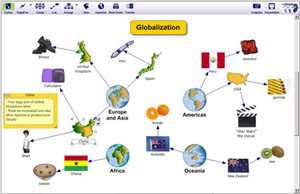Globalisation
Sakshi Education
 Key Points:
Key Points: - Globalisation is the process of rapid integration of countries. There are three types of movement within international economic exchanges. a) The flow of trade in goods and services. b) The flow of labour by the migration of people c) The movement of capital for investments over long distances
- An MNC is a company that owns or controls production in more than one nation. MNCs set up factories for production is regions where they can get cheap labour and other resources so that they can get greater profits.
- Integration of markets and production through trade and investments controlled by multinational corporations with huge wealth and power is one of the hallmarks of the present phase of globalisation.
- Liberalisation is the process which removed the barriers to trade and investment and opened the economies to the forces of globalisation.
- The benefits of globalisation have been unevenly distributed. It has benefited well-off consumers and also producers with skill, education and huge wealth.
- International organisation like World Trade Organisation (WTO), World Bank (WB) and the International Monetary Fund (IMF) represent the interests of the developed countries for more than that of the developing world.
- Globalisation has also created new opportunities for companies providing services, particularly those involving Information Technology (IT).
- Critics of globalisations argue that globalisation harms democracy, workers rights and the environment is many of the poor countries. They point out that it is another attempt by some countries read the west to dominate the world.
- In the few years, massive campaigns and representation by people's organisations have influenced important decisions relating to trade and investments at the WTO.
- MNCs: An MNC is a company that owns or controls production is more than one nation. MNCs set up offices and factories for production is regions where they can get cheap labor and other resources so that they can earn greater profits.
- Nation State: Countries interlink in trade and political issues.
- Technology: Scientific advancement. Rapid improvement is technology has been one major factors that has stimulated the globalisation process. The developments in information and communication technology have been even more remarkable and rapid.
- Foreign Investment: The investments made by the MNCs and other foreign institutions.
- Foreign Trade: Exports & Imports.
- Liberalisation: Removing barriers on international trade. It means goods could be Imported and exported easily and foreign companies could setup factories and offices here.
1. "The impact of globalisation has not been uniform." Explain this statement?
- The globalisation depends on three factors. They are
a) Technology
b) Liberalisation of Foreign Trade
c) Foreign Investment Policy - The globalisation is speeded up in the developing countries than the developed countries. Rapid improvement in technology has been one of the major factors that stimulated the process of globalisation.
- Removal of trade barriers on foreign trade and investments has been second influencing factor that promoted exports & imports. This also has encouraged foreign companies to set up factories and officers in developing countries, which in turn stimulated the globalisation process.
- Some countries do not follow the liberalisation of foreign trade, which restricts the trade with those countries. This brings non-uniformity in the globalisation.
- Globalisation has enabled some large Indian companies to emerge as multinational corporations. Particularly the information technology sector has provided myriad opportunities to Indian companies.
- Foreign investments have increased in India with globalisation.
- The central and state governments have set up special economic zones to attract foreign companies to invest in India, which have not lived up to the expectation. Thus the impact of globalisation has not been uniform.
- The nation state with people organised on territorial grounds laid the psychological foundations for creating a feeling for one’s own country, the feeling of nationalism. The single most important impact of globalisation is the gradual dilution of this feeling.
- The globalization leads to cultural homogenisation, with the impact of modern communication and technology has led the spread of certain cultures and ideas which have marginalised local and small cultures.
- Languages of international communication such as English have gained broader acceptance, mostly at the cost of national languages.
- The globalization may harms democracy. Workers rights and the environment may be affected in many of the poor countries.
- The peoples’ organisations can play an important role in the decisions relating to international trade and investments.
- Since globalisation is now a reality, fair globalisation would create opportunities for all and ensure that the benefits of this global process are shared better.
- There would be an expansion of MNCs and trade with the globalisation. The small producer would be disappeared. The cost of production would come down.
- Tax on imports is an example of trade barrier. Government can use trade barriers to increase or regulate foreign trade.
- After independence, the Government of India had put barriers to foreign trade and investments to protect the local manufacturers from foreign competition. Thus protection had given to domestic companies through a variety of means.
- Around 1991, India shifted to liberalisation policy. The government decided that competition would improve the performance of producers with in the country and this decision was supported by powerful international organisations.
- Thus, barriers on foreign trade and foreign investment were removed to a large extent in 1991. This means that goods could be imported and exported easily and also foreign companies could set up their factories and offices here.
- The flexibility in labour laws helps the companies is getting employees who are willing to work at lower wages.
- The flexibility will help companies to get indentured laborers.
- An indentured labourer is a bonded labourer under contract to work for an employer for a specific amount of time to pay of his passage to a new country or home. Living and working conditions for such labourers were often harsh and they hardly have any legal rights.
- Hence, the flexibility in labour laws only helps the companies but not the labourers.
1. What are the different ways in which MNCs setup, or control production in other countries?
- MNCs are playing a major role is the globalisation process.
- The criteria for selecting a site for operations of MNCs are-
a) Proximately to the markets
b) Availability of skilled and unskilled labour at low costs
c) Assured availability of other factors of production
d) Governments that can protect their interests - MNC investments are used to buy up local companies and then to expand production
- Large MNCs in developed countries place orders for production with small producers and sell them under their own brand names.
- Large MNCs have tremendous power to determine price, quality, terms of delivery and labour conditions of these distance producers.
- Developed countries want to turn the developing countries as their markets. That’s why they urge developing countries to reduce taxes on imports.
- Developing countries can demand the developed countries to give job opportunities to their people.
- The developing countries are in turn may ask the developed countries the gas and the natural fuels at lower cost.
- Foreign trade leads to integration of markets across the countries as they become interdependent on each other.
- Foreign trade creates an opportunity for the produces to reach beyond the domestic markets.
- Chinese manufacturers started exporting plastic toys to India. Buyers in india now have the option of choosing between India and the Chinese toys. Because of the cheaper prices and new designs, Chinese toys became popular in the Indian markets.
A. Globalisation is definitely helping India’s developments is several ways. They are
- It has created greater competition among producers
- It is offering greater choice and quality
- It has brought down the prices of several products and services
- The foreign investment has increased
- Some Indian companies have emerged into multinational corporations
- Created new opportunities for companies providing services in IT industry.
- To certain extent it has hurt our country’s development by punishing small producers.
- Removing barriers or restrictions set by the government on businesses is known is liberalisation.
- The investments of MNCs directly promote the globalisation process.
- Collaboration of MNCs with local countries helps the globalisation process.
- Setting up of special economic zones by the central and state governments to attract foreign companies to invest in India.
Published date : 19 Dec 2014 12:49PM


















